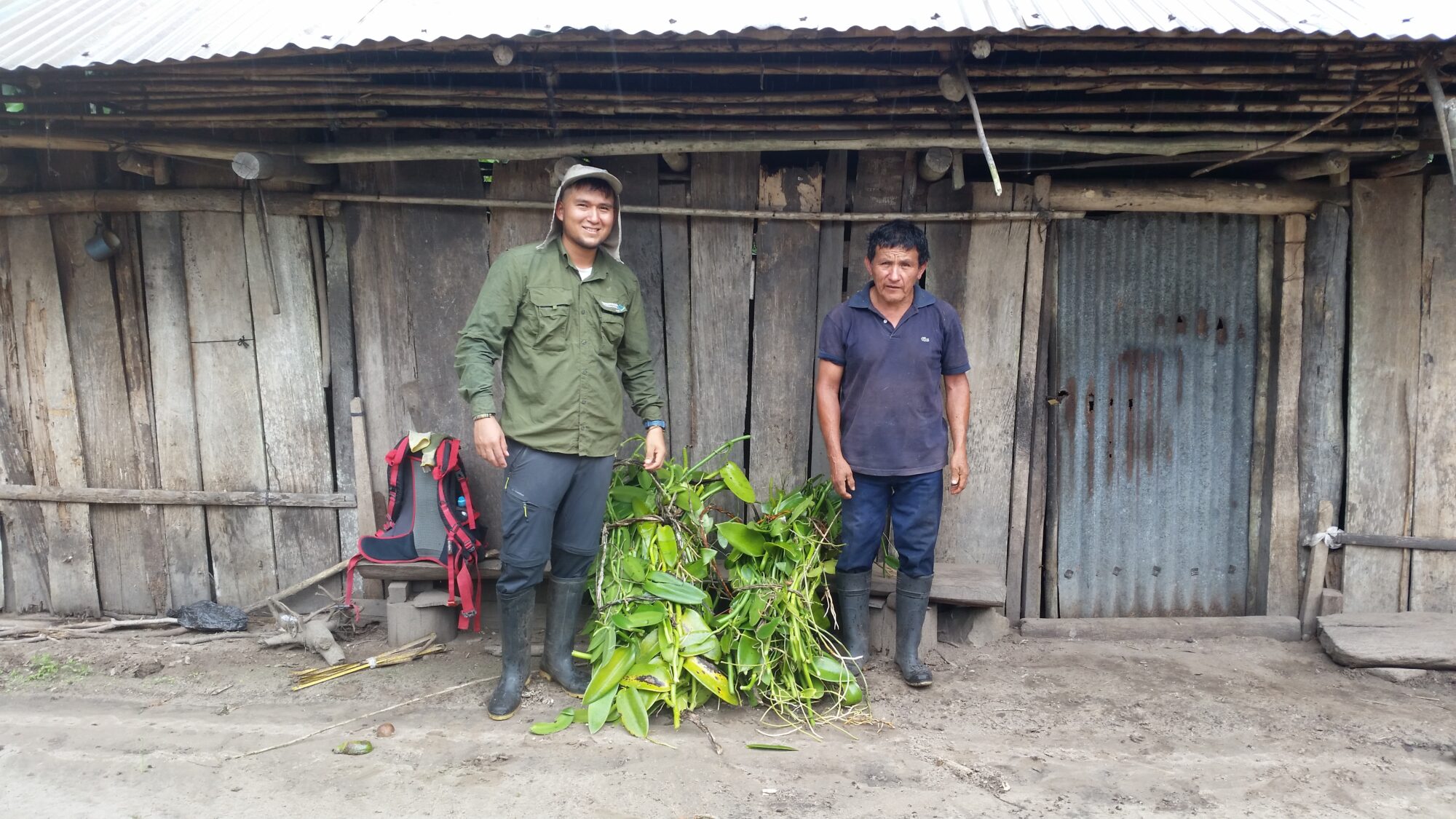The great wild queen

Pompona Vanilla is a new product not only for us. The world market for vanilla is dominated by Vanilla Planifolia, its main production is located on the islands of the Indian Ocean. However, the more than 100 species of the vanilla orchid genus (Vanilla), a subfamily of orchids, originally come from the rainforests of Latin America. (1) Wild species still exist in the dense Amazon rainforest. One of them is the Vanilla Pompona Grandiflora.
As its name suggests, it has particularly pompous large flowers, and its fruits are also much larger than those of other vanilla species. Unfortunately, there is little experience in its cultivation. Few Peruvian farmers have a few plants on their fincas, more as a joke than anything else. Only a handful of farmers are cultivating professionally – in the whole of Peru. In the wild, vanilla shows its unique reproductive strategy. Its flowers have a very low pollination rate of around 1% in the wild, but one fruit can produce around one million seeds. (2) After pollination, the pod matures and slowly opens. Now the beguiling smell is spread. Gradually, the seeds fall down from the fruit and are carried away. Only a tiny fraction of them will germinate and grow into plants. The sheer mass of seeds alone ensures the vanilla plant’s continued existence.
We heard about wild occurrences of Vainilla Pompona Grandiflora in the jungle near Moyobamba in 2017 and 2018. During this time, before cumpa was founded, Lukas was investigating the effect of wild bee occurrences on coffee production as part of his studies. (3) For this, he was in contact with Arturo, a studied expert in environmental resources, the breeding of wild bees (Meliponicultura) and agriculture. In addition to his extensive knowledge of bees, we were fascinated by Arturo’s idea of cultivating wild vanilla orchids. Arturo owns a small piece of land bordering the swampy rainforest reserve of Tingana near Moyobamba, which he cultivates together with Don Santos, who lives there. During Lukas’ student internship semester 2017/2018, we worked here a few times. On one occasion, we planted dragon fruit (pitahaya) with Arturo. For the night we stayed in the hut in the jungle. In the evening, groups of different species of monkeys came in search of food and found it among the bananas near the hut. In the morning, together with Don Santos, we went in search of the queen of spices.
We waded through the rainforest for about an hour. Mosquitoes, wasps, bees, horseflies and biting flies abound here in the floodplain, we tasted them quite well. Finally we entered a clearing where we found the vanilla orchid. The orchid climbs out of the water up dead trees to several feet in search of full sun. We found about 6 plants. In addition to the fleshy leaves, we discovered various mature fruits and flowers. What a moment! As one does in the rainforest, we drank a sip of water from our bottle and then, using the machete, first cut “sogas” (ropes) from old tree bark, for transporting the plants. Don Santos climbed up the dead tree next to the vanilla and started cutting the plant every 50cm with the machete. Back on the ground, or more precisely in the water, we tied the clones with the sogas and carried them on our backs through the forest back to the hut. After taking a breather, we planted the vanilla plants together in a wet section of the finca. Don Santos and Arturo would henceforth see to it that the wild queen fared well even in domesticated conditions. With the right care and a little luck, the prospects were good to be able to harvest vanilla fruit in a few years.
For more info on the product, click here.
Sources:
(1) https://www.researchgate.net/publication/352715442_III_CONGRESO_INTERNACIONAL_DE_LA_VAINILLA_EDICION_ESPECIAL page 70, (2) https://www.researchgate.net/publication/288609351_Pollination_of_Vanilla_and_evolution_in_Orchidaceae, (3) https://www.researchgate.net/project/Co-creational-Strategizing-for-Peruvian-Coffee-Farmers/update/5ac0a5cfb53d2f63c3c33740